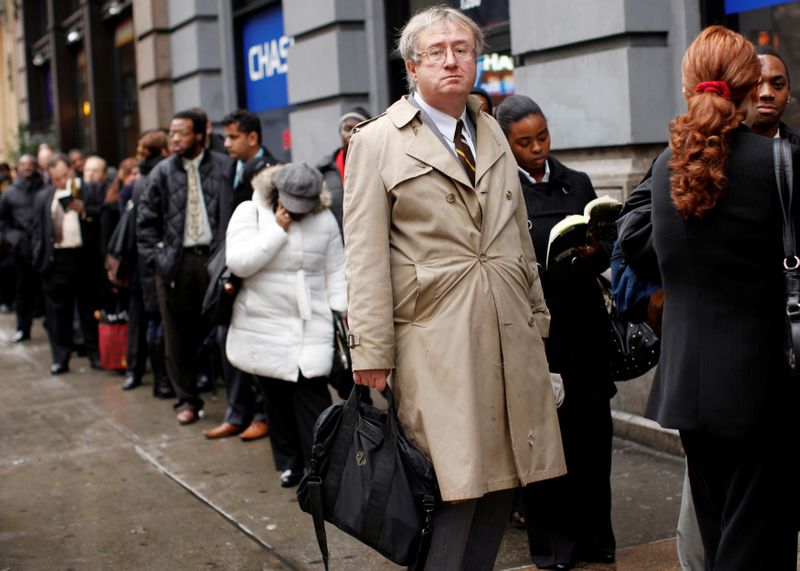WASHINGTON (Reuters) – The number of Americans filing new claims for unemployment benefits rose last week, likely boosted by brutal winter storms in the densely populated South in mid-February, though the labor market outlook is improving amid declining new COVID-19 cases.
That was confirmed by other data on Thursday showing job cuts announced by U.S.-based companies plummeted 57% in February. The labor market has lagged an acceleration in overall economic activity, driven by nearly $900 billion in additional pandemic aid provided by the U.S. government in late December.
Federal Reserve Chair Jerome Powell also struck an optimistic note on the labor market on Thursday, telling a Wall Street Journal forum that there is “good reason to expect job creation to pick up in the coming months.” Powell, however, said there is still a lot of ground to cover for the labor market to get back to a state of full employment.
Initial claims for state unemployment benefits increased 9,000 to a seasonally adjusted 745,000 for the week ended Feb. 27, the Labor Department said. Economists polled by Reuters had forecast 750,000 applications in the latest week.
Unadjusted claims rose 31,519 to 748,078 last week, boosted by filings in Texas and New York, as well as in Ohio, which has been plagued by fraudulent applications.
Stormy weather in the South left large parts of Texas without power or water for days. The deep freeze shut oil production and refineries in Texas, the biggest producer of natural gas and oil in the United States.
Including a government-funded program for the self-employed, gig workers and others who do not qualify for the regular state programs, 1.2 million people filed claims last week.
But the sun is slowly starting to peek through the clouds shrouding the labor market. In a separate report on Thursday, global outplacement firm Challenger, Gray & Christmas said U.S. companies announced 34,531 job cuts in February. That was the smallest number since December 2019 and was down from 79,552 January.
“The jobs picture is beginning to firm up again after a rough winter,” said Sarah House, a senior economist at Wells Fargo Securities in Charlotte, North Carolina.
U.S. stocks were trading lower. The dollar rose against a basket of currencies. U.S. Treasury prices fell.
LONG ROAD TO RECOVERY
A drop in daily coronavirus cases and hospitalizations helped to lift consumer spending in January. Though the pace of decline in infections has stalled, economists believe the labor market will accelerate in the spring and through summer, noting that vaccinations were increasing daily.
A boost to hiring is also expected from President Joe Biden’s $1.9 trillion recovery plan, which is under consideration by Congress.
Still, the road to recovery remains long and difficult.
Though weekly jobless claims have dropped from a record 6.867 million in March 2020 when the pandemic hit the United States a little more than a year ago, they remain above their 665,000 peak during the 2007-2009 Great Recession.
In a well-functioning labor market, claims are normally in a range of 200,000 to 250,000.
The number of people receiving benefits after an initial week of aid dropped 124,000 to 4.295 million during the week ended Feb 20. But that was mainly due to people exhausting their eligibility for benefits, limited to 26 weeks in most states.
About 4.465 million people were on the government-funded extended benefits program during the week ended Feb. 13. At least 18 million people were on unemployment benefits under all programs in mid-February.
“This underscores just how far the nation is from a genuine labor market recovery,” said Andrew Stettner, a senior fellow at The Century Foundation.
Government-funded unemployment benefits will expire in mid-March if Congress does not pass the Biden administration’s relief package, affecting nearly 12 million people.
Last week’s claims data has no bearing on February’s employment report as it falls outside the period during which the government surveyed establishments and households. According to a Reuters poll of economists, the government will likely report on Friday that nonfarm payrolls increased by 182,000 jobs in February after rising by only 49,000 in January.
Hopes for a pick-up in hiring last month were supported by a survey last week showing consumers’ perceptions of the labor market improved in February after deteriorating in January and December. In addition, a measure of manufacturing employment increased to a two-year high in February.
But those expectations were tempered by reports on Wednesday showing private employers hired fewer-than-expected workers in February. Employment growth in the services industry retreated last month, with businesses reporting they were “unable to fill vacant positions with qualified applicants.”
The year-long COVID-19 pandemic is keeping some workers at home, fearful of accepting or returning to jobs that could expose them to the virus. Millions of women have left the labor force to look after children as many schools remain closed.
The Fed’s “Beige Book” report on Wednesday noted “continued difficulties attracting and retaining qualified workers” reported by many of the U.S. central bank’s contacts last month, with labor shortages “most acute among low-skill occupations and skilled trade positions.” The Fed’s contacts cited the coronavirus, childcare, and unemployment benefits as factors behind the labor supply problem.
(Reporting by Lucia Mutikani; Editing by Chizu Nomiyama and Paul Simao)



















